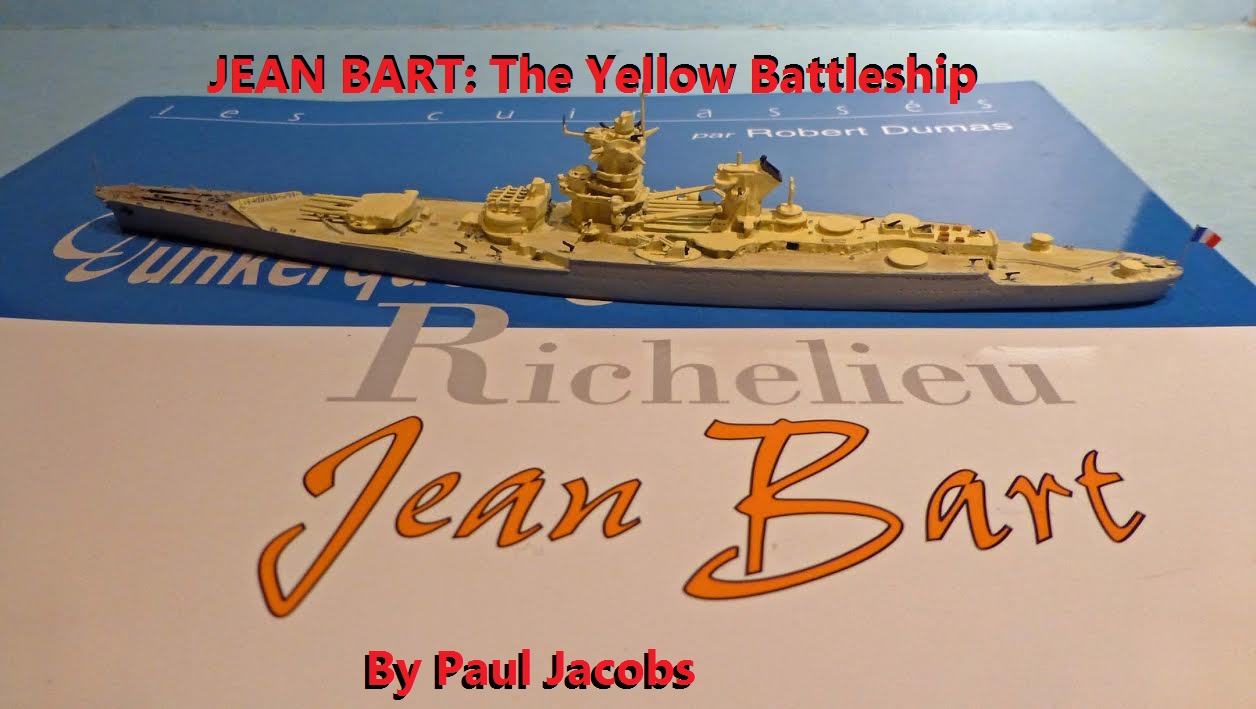 |
 |
JEAN BART: The Yellow Battleship
In June 1940, with German forces rapidly advancing and France on the verge of collapse, the French managed to get the partially completed battleship JEAN BART, sister ship to the RICHELIEU, underway and moved to Casablanca. Far from combat ready, the ship sat there, incomplete until February 1945 when she was moved back to France. But her time at Casablanca was not uneventful.
At Casablanca work continued on the ship, albeit at a very reduced pace, as materials were not readily available. Her forward main battery turret with four 15" (380mm) guns was completed and the guns test fired. Although no secondary armament was available, anti-aircraft weapons were mounted over a period of time, and some structural changes were made. With no place to go, the ship was moored next to a wharf with her bow facing the sea, and she became little more than a floating artillery battery.
On November 8, 1942, the Allies invaded French North Africa, and U.S. forces were assigned to the landings in Morocco. U.S. Army troops were landed on beaches near Casablanca and as a result French and American military forces clashed. Besides the JEAN BART, the French had the cruiser PRIMAUGUET, contre-torpilleurs MILAN and EPERVIER, a half dozen destroyers and a number of submarines at Casablanca. As a result there occurred the Naval Battle of Casablanca, a one sided affair that resulted in the sinking of many of the French ships. The JEAN BART engaged in a long range duel with the U.S.S MASSACHUSETTS, but lacking adequate fire control equipment, and being immobile, got the worst end of the exchange. In addition, the ship was bombed repeatedly by aircraft from the U.S.S RANGER. When the fighting finally ended and the French capitulated, JEAN BART had suffered serious, but not fatal damage. In 1943 the French sought to have the ship moved to the U.S. to be completed for war service, but the U.S. Navy declined, not wishing to devote substantial resources to completion of a battleship that they felt was not needed.
After the war the ship was substantially rebuilt in France and served actively from 1955 to 1957, eventually being scrapped in 1970.
There is no commercially made model of the ship as she appeared during the war, and I had long wanted to do a conversion but was deterred by the amount of work necessary to accomplish that. But finally, I decided to take up the challenge.
My choice for alteration was the Neptun RICHELIEU (N 1401) which depicts the ship as built. A lot of parts had to be removed as can be seen in some of the photos. Many could be cut off with a hobby knife or Dremel rotary blade, but others had to be ground off, never an easy task and fraught with danger to parts that one wants preserved. In the end, some things I wanted to save could not be. Once all the parts were removed, then it was easy to apply paint remover and get down to bare metal. There was not much left that could be damaged in the course of removing the paint.
After removing the paint the areas needing further work were more apparent. Additional sanding and filing smoothed out the decks. A thin coat of gray paint revealed anything more needing sanding, and so that was done, again and again until the decks were smooth and flat.
Next came the building and placement of new parts, visible as white plastic in the photos. And then, painting.
Getting the details and the paint work right was another challenge. Adequate documentation was a problem as the photographic record is somewhat scant. In order to do the model I had to rely upon several sources, and in some regards they conflicted, especially regarding the paint scheme. Fortunately one book I have has detailed drawings of the deck plan showing the armament changes at various times between June 1940 and November 1942. But other structural changes were not so easily determined. Between June 1940 and Nov 1942, while the ship sat in Casablanca harbor, construction work continued on it, albeit very slowly. Most of the photographic record is of the ship as she was rebuilt after the war, which was very different. As for the paint scheme, I found at least three conflicting color drawings, but ultimately was able to base it upon a video on YouTube showing the ship in color after the Battle of Casablanca in Nov '42. This film matched one of the drawings, and therefore that's what I used. If the upper works look yellow, that's because they are; a pale yellow, which was done as a form of camouflage to make the ship blend in with the grain elevators adjacent to where the ship was moored.
This is not a simple conversion, and I would not recommend trying it unless you are experienced at doing projects like this.
Among the sources used were:
French Battleships 1922-1946 by Jordan and Dumas (2009)
Le Cuirasse JEAN BART (1939-1970) by Dumas (1992)
https://laststandonzombieisland.files.wordpress.com/2015/04/bb-jean-bart-1940-1.png
YouTube: "JEAN BART: A damaged French battleship in Casablanca Harbor."
1. The Neptun model before conversion
3. Grinding begins.
4. More grinding.
6. Paint remover applied.
8. Paint has been applied to areas that have been ground and filed but still need sanding. The paint aids in showing where flaws still exist.